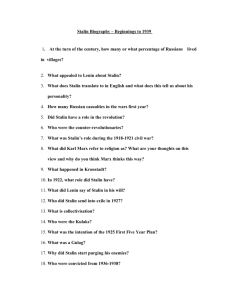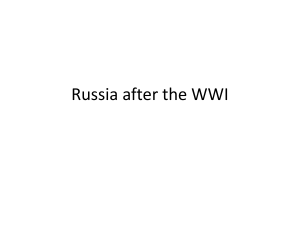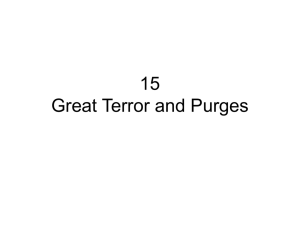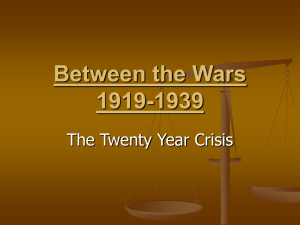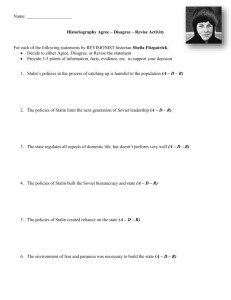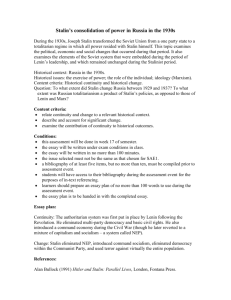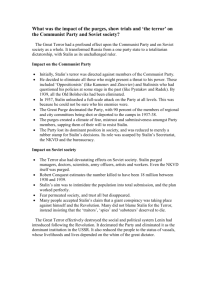Stalin's Russia 1924 - 1953
advertisement
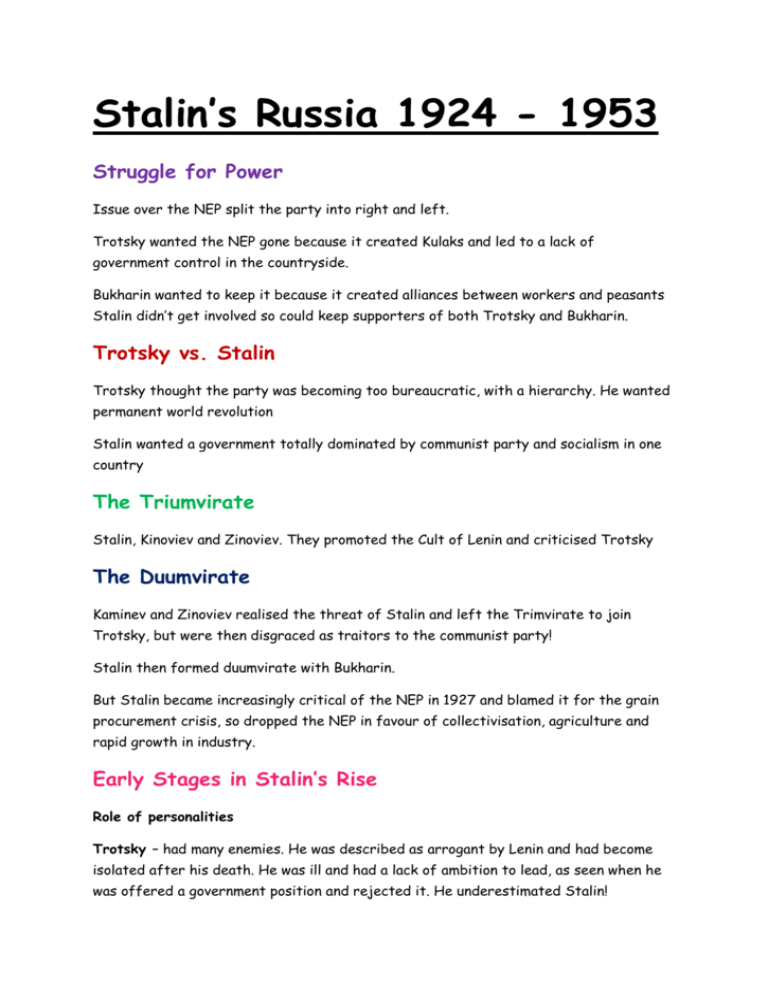
Stalin’s Russia 1924 - 1953 Struggle for Power Issue over the NEP split the party into right and left. Trotsky wanted the NEP gone because it created Kulaks and led to a lack of government control in the countryside. Bukharin wanted to keep it because it created alliances between workers and peasants Stalin didn’t get involved so could keep supporters of both Trotsky and Bukharin. Trotsky vs. Stalin Trotsky thought the party was becoming too bureaucratic, with a hierarchy. He wanted permanent world revolution Stalin wanted a government totally dominated by communist party and socialism in one country The Triumvirate Stalin, Kinoviev and Zinoviev. They promoted the Cult of Lenin and criticised Trotsky The Duumvirate Kaminev and Zinoviev realised the threat of Stalin and left the Trimvirate to join Trotsky, but were then disgraced as traitors to the communist party! Stalin then formed duumvirate with Bukharin. But Stalin became increasingly critical of the NEP in 1927 and blamed it for the grain procurement crisis, so dropped the NEP in favour of collectivisation, agriculture and rapid growth in industry. Early Stages in Stalin’s Rise Role of personalities Trotsky – had many enemies. He was described as arrogant by Lenin and had become isolated after his death. He was ill and had a lack of ambition to lead, as seen when he was offered a government position and rejected it. He underestimated Stalin! Kaminev and Zinoviev – were politically naïve. They were too intellectual and engrossed in political debate, causing them to fail to see Stalin building up support. Bukharin – described as the “party sweetheart” as he was so nice. He was loyal to Stalin and during Stalin’s left turn he just gave up and resigned. Stalin – cunning, manipulative, ruthless, underestimated. This is seen in his exploitation of positions, such as GENSEK. He tapped phones, abused the ban on factions and contolled who sat I meetings, building himself support. Agriculture USSR was 50-`100 years behind and had to catch up in 10 years or be crushed. Stalin wanted agriculture and industry to work together Reasons for Collectivisation Economic reasons for Collectivisation Modernising farming to make it more efficient Produce more grain with fewer workers – sharing equipment, living on collectives etc To cheaply feed industrial workers to aid the 5 year plans To create more grain for exports in return for machinery for both farming and industry Ideological Reasons for Collectivisation End capitalism and private ownership and end NEP To end the Kulaks who aided capitalism Political Reasons for Collectivisation To strengthen communism through greater control over collectives To increase the number of industrial workers through surplus farmers To teach peasants about communism in larger, united units. Personal Reasons for Collectivisation Helped Stalin outmanoeuvre his rivals Peasants were traditional and not all of them had support for communism or Stalin. It was easier for Stalin to brainwash peasants on united collectives Kulaks were made into scapegoats for peasant opposition = dekulakisation But farming suffered from their removal Collectivisation of Agriculture Grain procurement crisis 1928 – food shortages so people hoarded it! Secret Police and soldiers requisitioned grain People had to give up their land, homes and animals and get moved to collectives Private ownership abolished Consequences of Collectivisation People began to destroy things like animals and grain, rather than hand it over to the state Stalin blamed local officials! Many left collective farms Stalin’s left turn Stalin re-introduced Collectivisation and by 1934, 70% if all farms were collectives 1930 Dizzy with Success speech – “shouldn’t have forced collectivisation on you! You can plant more crops and get some profit!” But this was a lie and he requisitioned all the grain through his re-launch of collectivisation This renewed peasant opposition and led to more famine 1932 and disappointing agricultural output Private plots allowed 1932 and model charter 1935 allowed a compromise with peasants – neo NEP – peasants could sell surplus from private kitchen plots This helped 5 Year Plans by providing A steady output of grain to the cities, as well as increasing exports Collectives didn’t need as many farmers so many went to work in cities and boost industry Party Control Churches converted int barns or clubs, minimising the influence of the Orthodox Church Lots of control over the countryside! “Socialism in the countryside”” Stalins hold on the party increased, getting rid of anyone who wasn’t loyal! Results of Collectivisation Agriculture began to recover, but was limited The Rural population fell Stalin was arguably more interested in removing political enemies (kulaks) Neo NEP as a result of peasant opposition = compromise with capitalism Social results Food Production disrupted, so was initially less grain Peasants could benefit from kitchen plots State procurement of grain increased, regardless of the harvest Contributed to rural famine Economic Results More efficient farming, arguably Extra farmers involved in the city Urban population doubled But many agricultural workers still unskilled and using backward methods Shortage of peasant produce such as nails and bricks Still dependant on man power Political results Socialism in the countryside had to be forced Had more control over the Peasants Easier to control collectives BUT still passive opposition! Industrialisation and the Five Year Plans Reasons for the Plans/economic problems The economy was backward and the NEP was too slow. With Russia only ust reaching 1913 levels of production in major industries “We are 100 years behind and have 10 years to catch up or be crushed!” Limited machinery – relied heavily on man power Production was very limited Unemployment Shortage of grain which was needed for industrialisation (food and exports) NEP unpopular with left due to ideology and trying to achieve socialism in one coutry Stalins personal ambition – left turn – outmanoeuvre Bukharin and end the triumvirate Political reasons as would strengthen the communist party as they wold control all of industry Need to develop industry before agriculture – machinery for modern farming The Plans The First Five Year Plan 1928-1932 Created and administrated by Gosplan Concentrated on steel, iron, machines, tools, electricity and transport Targets = 115% coal, 200% Steel, 335% electricity Workers who did not reach their targets were publically humiliated and could even be sent to the dreaded Gulag! Those who succeeded targets were rewarded – motorbikes and wage differentials! Created specialist workers – stahanovites The Second Five Year Plan Focuesed on new industries such as fancy chemicals! Concentrated also on heavy industry and steel production Also focused on communications More consumer goods were promised 2nd Five Year Plan 1933 - 1937 Aimed to improve agriculture with machines/tractors Transport links were improved SOME attempts at increasing consumer goods, but still a low priority Show pieces for propaganda e.g Moscow metro System of wages introduced Some industries fell short of goals – oil fell short by 20 million tons , but output overall increased Diverted into amunitions 3rd Five-year plan: (1938-1941) Different priorities as war with Germany was increasingly likely More consumer goods such as radios and cars Produced things to help the war- aircrafts, taks weapons and by 1940 1 third of the budget on military Output grew little due to purges which imprisoned or executed many workers Had a stable workforce – internal passports – prevent SOME flitting Successes of the Plans Created new industries from scratch focusing on coal iron and steel Created MAGNITOGORSK in the Urals, which started off as a small village and ended up as one of the biggest industrial centre in the world Doubles heavy industry output Seemed to transform economy as they claimed they finished in 4 years 2nd plan introduced new industries such as chemicals More communications that helped move resources around the country SOME more consumer goods e.g bread Stakanovites = exceeding of targets and created specialisation Show pieces such as the Moscow Underground – shows what Russia was capable of 3rd plan had a huge scale of ammunitions Urban Population doubled! = huge increase in workers Growth in use of electricity and hydroelectric power New towns created from scratch! Stalinos More tractors in the 2nd Plan Failures of the Plans Poor quality! E.g Gigantomania – big, but crap quality Fraud – people exaggerated their targets Machines often broke down and people weren’t trained Inefficiency – duplication and waste Poor planning by people who didn’t understand the economy “Flitting” occuered where workers went from job to job to find better conditions. This was illegal! Shortage of nails and bricks after collectivisation disrupted the peasant’s lives Emphasis on show! Still largely relied on man power Terror and Purges The First Purges, 1930–33 Including anybody who opposed industrialisation, and the kulaks who opposed collectivisation. The Great Purges, 1934–39 Political Opponents 1934: Kirov, a rival to Stalin, was murdered. Although he probably ordered the assassination, Stalin used it as a chance to arrest thousands of his opponents. 1934–1939, Stalin’s political opponents were put on ‘Show trials’, where they pleaded guilty to impossible charges of treason (e.g. Zinoviev and Kamenev 1936/ Bukharin, Tomsky & Rykov 1938). Purges of Party Ryutin challenged Stalin, and called for a ‘fresh start’ calling Stalin the “gravedigger of the revolution”. Stalin called for his immediate execution- the party successfully argued against him and he was instead imprisoned for 10 years. He was eventually executed, but the Ryutin affair showed that Stalin didn’t have full control- maybe explaining why earlier purges concentrated on the party itself. Kirov (leader of Lennigrad Communist Party) was murdered, probably on prders of Stalin cause he got more votes. Stalin used this to his advantage and anyone suspected of disloyalty was murdered, sent to prison/work camps or put onto public trials. Communist leadership purged – 93 out 0f 139 members killed Communist party was purged – millions of its member killed out of 3 million All those who played a role in Lenin’s government were purged Stalin was the only one left from the original politburo Trotsky exiled, then executed 1940 Purges of the Army Claimed they had/supported Nazis 1 third of army officers purged Removed 3 of 5 officials, and 13 of 15 commanders Showed Stalin was losing touch with reality as he needed them for the expected war!! Mass Murder NKVD orderd to remove anti soviet elements Produced a list of 250000 people to be executed 1.5 million executed overall The purges – Why? Some argue Stalin set up the terror to tighten control and strengthen his position Others argue the terror was a logical consequence of communism Revisionists argue the terror resulted from competing members of the communist party The purges – how? Murder of kirov, Yogoda Run first by NKVD bosses – Yogoda, then Yeshov, then Beria Hundreds of thousands of party officials, army officers, and ordinary citizens were arrested, imprisoned, or shot Leading counter revolutionaries were publically tried in show trials All old Bolsheviks were removed The Purges – Results Climate of fear created in the Soviet Union People lived in constant fear of being denounced Disruption to industry and economy Red Army greatly weakened Stalins grip on soviet state stronger than ever The Show Trials Show trials Occurrences First Trial 1936 – first trial (Trial of the Sixteen) was of the Trotskyist-Zinoviette Terrorist centre (Kaminev and Zinoviev etc) The accused were forced to sign false confessions and were coached on what to say They were told their families would be spared if the “confessed” Accused of conspiring to murder Kirov – when this was most likely Stalin Accused of undermining the 5 year plans 2nd Trial 1937– “Trial of the Seventeen” - Red Army Chief accused of spying, arrested and shot along with thoasands of officers and admirals Accused close friends of Lenin of spying for Nazis 3rd Show trial – Yogoda, Bukharin, and Rykov. And eventually Trotsky in 1940 Bukharin accused of plotting to kill Lenin Purpose of the trials Eliminate Stalin’s enemies- real AND imagined to secure his position, perhaps because of Stalin’s paranoia To demonstrate Stalin’s power and strength Stalin wanted revenge on those who had earlier underestimated him and criticised him and his policies Act as a warning to others to not oppose Stalin Create a climate of fear so people obey Stalin Justify the NKVD terror Provide scapegoats for failiures in industry Confirm Stalins role as saviour for uncovering plots – cult of personality Results of the Show Trials Confirmed Stalin’s leadership and his Policies – removing Old Bolsheviks Stalin was surrounded by “yes men” Rival authorities eg NKVD bosses, were controlled, strengthening Stalin’s hold over party and state Contributed to a climate of fear in which people denounced others to show their loyalty - increased use of terror in the Gulag People mostly cooperated, or at least pretended, with Stalins policies but were passivly resistant Did not get to the bottom of the problems Disrupted industy by loss of experts to the show trials. Life in Stalin’s Russia Women in Stalin’s Russia Women in Industry Women already encouraged to work by Lenin, though most men did not help at home Women encouraged to help work on the 5 year plans Between 1922 and 1937 2 of new factory workers were women Lenin had already created nurseries for the children, which helped indoctrinate children from an early age! Collectivisation Women had traditionally played a large role in farming Stalin wanted to make sure they were a large part of the collective work force Stalin’s attitude to Women He had traditional views He was prudish Wanted women to work, but didn’t approve of things like free love! Because of this, he was against many of Lenins ideas regarding family “The Great Change” After the communist revolution, family life was under great strain Industrialisation, collectivisation, and famine caused thoasands of families to break up Huge increase in the amount of abandoned children and juvenile crime became a massive issue Stalin Policies and Views – Great Retreat Stalin enforced a series of laws curbing lenins reforms on the family Homosexuality and Prostitution were made illegal Need to increase populatin so introduced the “Family Code” 1936, whereby abortion was outlawed Family code reflected Pravda 1935, which told children to love and respect parents The Great Retreat - Divorce became more difficult and expensive. CWomen were told they had no right to deny the joys of motherhood, and women with more than 6 children were rewarded! Stalin regarded the family as an ideal unit of discipline Did women have it better under Stalin? Yes Many women had greater access to education and to a professional career Could be rewarded for having a big family Greater educational opportunities for women Women represented the stakhanovite movement in the countryside Wives o party officials were could be involved in politics – but were still pretty much ignored in the ccommunist arty and expected to stay and look after the house and involvement in politics was frowned upom No Many argue that life became harder because their rights decreased as well as increased pressure to work AND bring up children at the same time Harsh living conditions – often shared and overcrowded housing Women bore the brunt of everyday problems e.g. Bread queues Could not have an abortion – almost forced in to having children Women who had illegitimate children were badly stigmatised Few married women had time to join the communist party Often had lower positions at work Got paid less than men Women still expected to look after the home as well as work – duel burden and triple shift Education under Stalin – great retreat Nursery, primary, secondary schools and Universities were increased Education was very strict Range of subjects, but always taught hard work, obedience and loyalty, indoctrinating children into ideologies of communism Communist policies became the most important subject Went back to traditional teaching methods Young people were encouraged to go into higher education and adults encouraged to go into adult teaching programs Stalin encouraged people to take up mathematics, science and technology. Women could even get university places – 60% undergraduates were women Education geared towards creating the new, super, soviet man! Religion under Stalin Communists wanted to eradicate religion Illegal to hold religious ceremonies Churches closed and priests accused of spying Religious people taxed more and their children not allowed to go to school Wearing Wedding rings was banned Culture and Arts Art before Stalin Incomprehensible to Russian masses Painting was very experimental e.g “Here is a black dot on a canvas” Russian art celebrated modern technology in the form of modern art Reconstructing the Arts Stalin hated soviet art! Believed art should help promote government views, not individual creativity Social Realism-Artists for workers and leaders Art reflected party spirit, national spirit and representing new thinking Also sold economic and social policy to the Russia people Artists were set targets for the number of works they had to produce Socialist Realist art was designed to inspire the workers The five year plans were the main focus of the paintings Artists also tried to glorify Collectivisation, showing plenty of food and machinery in the countryside, even though there was famine Stalin wanted to give the impression he was Lenin’s right hand man, and wipe other important figures from Russia, particularly Trotsky Erased Trotsky from the party history Stalin had people removed from paintings and pictures e.g Yogoda Emphasis on Russian heroes nd stakhanovites The Cult of Personality Stalin wanted idolisation of Lenin to strengthen his regime and give people something to replace the symbol of Christianity Paintings of Stalin often hinted that the ghost of Lenin was always with him – painting “long live the Stalinist order of heroes and stakhanovites Good things in life associated with Stalin Represented Stalin as a war leader, world leader, an intellectual, lover of children, demi god. Not just about Stalin, but also about successes in the regime Conclusion Stalin’s regime was built on fear, but also visions of a better society to inspire people to continue through the hardships of industry and farming Stalin’s art allowed people to escape From everyday life, tying them more closely to the regime Socialist Realism as well as terror can be seen as a form of social control The Making of a Superpower The Great Patriotic WarTo what extent was the USSR ready for War 1941? Was Prepared/Strengths Had prepared for the invasion of Normandy for two years Trained huge forces Disipline in the Red Army was tightened with the reintroduction of divisions between army officers and men Started directing economy into aiding war Industry helped thewar, with armaments being produced and people working much longer hours –10 hours, 7 days a week. Anyone who was late for work was put in prison! Russia had a huge advantage over its foreign powers as it had extensive network of spies Russian war production compared favourably with that of the Germans, Germany spent more money on preparation from 1935-40, but by the ever of war Russia overtook German military spending, as the Russian economy was more powerful. By 1941 putting out 230 tanks and 700 aircraft per month Milit-experts consider Soviet T-34 tank was most effective tank of WWII GERMAN MISTAKES Assuming USSR was weak and collapse imminent, based on supposed weakness of postpurge army Assuming Blitzkrieg tactics would lead quick Germans to surround slow Red Army Was Not Prepared/weaknesses However Stalins paranoia undermind his efforts – no decent commanders During 1937 -8 the Red Army was purged meaning lots of experience was lost Did not plan for a specific type of war – Jack of all trades, master of none Not planned for a specific type of war, built forces to cope with all scenarios, kept changing priorities How was the USSR able to win the war? Outnumbered Axis forces Russian winter – repeatedly upset Nazi plans (1941 - 42, 1942 – 43) Resilience & determination of the Russian people (over 17 million killed, but they still fought on!) – ‘Borodino spirit’ – fostered by Stalin’s successful propaganda campaigns to raise morale, inc. not persecuting the Church (prepared to use any means to give the Russians the will to fight on) Strong leadership – Stalin (civil) & Zhukov (military) – Zhukov was largely given a free hand by Stalin in conducting the war, unlike Hitler who constantly meddled in military plans - Red Army reorganised effectively into modern fighting force with specialist units - ‘Tank Armies’; ‘Shock Armies’; partisans behind enemy lines; massed artillery formations - after damage of the Purges, Winter War & initial disaster of 1941. Terror among civilians and soldiers enforced by the NKVD & Death to Spies – ultimately the Soviet peoples had to fight even if they did not want to. Hatred of Nazis (sworn enemies of Communism) – especially after the atrocities committed against Soviet civilians. T34 tank – a decisive weapon – mass-produced – best tank of the war Industrial production continued in the east – 1300 factories moved from the war zone to the new industrial areas beyond the Urals e.g. Magnitogorsk. Aid from the western allies – intelligence reports from UK, (code-breaking carried out by ULTRA) and industrial products from USA – LAND LEASE – USA supported Russia in war my providing SPAM!!

